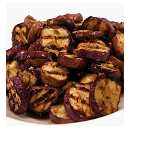The eggplant (also known as aubergine or brinjal (Solanum melongena)) is a perennial plant which is part of the night shade family of Solanaceae and genus Solanum. It is related to the tomato and potato and originates from India and Sri Lanka. Mature plants grow up to 150 cm (57 inch) tall and obtain large lobed leaves approximately 10 to 20 cm (4-8 in) long and 5 to 10 cm (2-4 in) broad. Spins occupy the stems, and its flowers range from white to purple in color with five-lobed corolla and yellow stamens.
The fruit contain small soft seeds which are edible and come in many shapes and sizes. The most common color is dark purple. There are also white-skinned varieties such as Casper. Eggplants are cold-sensitive vegetables that require seeding indoors first before being transplanted outdoors. They are hot weather plants, and should only be transplanted in the garden after frost has past.
Harvesting
Eggplants are harvested when they are about 6 to 8 inch long. Size, however, is not an indication of maturity. Press the flesh of the fruit and if the indentation of the pressure springs back, then the fruit is ready to be plucked. The fruit is immature if the flesh does not give, and over mature if the indentation stays and does not spring back. Over mature fruits should be removed from the vines and disposed. They will taste bitter. Use a knife or pruning shears to cut the fruits off the vines.
The fruits should be consumed as soon as possible after harvesting as eggplants do not keep particularly well.
Tip: If you look at the eggplants at the blossom end, you will find a dimple which can be either very round or oval in shape. The round ones are said to be less meaty and have more seeds, while the oval dimpled eggplants are more meaty. So choose the oval dimpled ones.
Storing Eggplants
Because eggplants bruise easily, remember to harvest them gently. Cut the eggplant with the cap and some of the stem attached and use them immediately to attain the best flavors. They are not suitable for canning or preserving, so you will need to store them by keeping them in the fridge. To store them, wrap the fruits in plastic and keep them in the refrigerator. They should keep for 1 to 2 days this way. They should be used while the stem and cap are still green in color.
Freezing the Fruits
If you wish to keep them longer, harvest the fruits before seeds become mature and the outer skin goes totally dark.
- Wash, peel (if desired) and slice the fruit into 1/3-inch thick slices. Do not spend too much time doing this as eggplants should not be handled too long.
- Blanch the fruit with water. Then boil one gallon of water with ½ cup of lemon juice for 4 minutes.
- After 4 minutes, cool, drain and pack the slices in package/jar with 1/2-inch head space. Then seal the package in zip lock freezer bags and freeze.
Tip: To make it easier to part slices that you want to use for frying, pack drained slices with a freezer wrap between slices before popping it into the freezer
Preparation and Serving
Eggplants have a small amount of nutrients. They make for delicious and versatile dishes at the dinner table. One cup of cooked and cubed eggplant contains 27.7 calories with 82 grams of protein, 6.57 g of carbohydrates, 2.48 g of dietary fibres, 21.78 mg of phosphorus, 245.52 mg potassium and 14.26 mg folate.
Eggplant tends to absorb a lot of oil when cooked. It has a fairly airy texture. This air within the fruit rushes out during cooking and is replaced by the cooking oil. To reduce the absorption of oil, salt and press (to drain) to remove air and water out of the sliced fruit before cooking. Salt, rinse and pat dry and add seasoning as required to balance the taste of the salt used.
Grilled Eggplants

Eggplants can be cooked in a variety of ways. They can be baked, grilled, steamed, or sauté-ed. To grill eggplants, slice the fruit to size and rub some oil onto the slices. Grill for a few minutes in a hot grillpan until the slices become soft and lightly charred.
Prepare a marinade of 5 tablespoon of olive oil, 1 tablespoon of lemonjuice, 0.5 tablespoon of pommegranate syrup, 1 clove garlic (grated), 0.5 tablespoon of dried oregano, 0.5 teaspoon of nigella seeds, 0.5 teaspoon of coriander seeds and 0.5 teaspoon of cumin seeds. Transfer the grilled eggplants to a bowl and pour with 2/3 of the above marinade into it. Reheat the prepared eggplant when you\’re ready to eat.
Eggplant Parmesan
Below is the recipe for eggplant parmesan dish that will serve approximately 6 people
What you need:
- One1.5 lbs eggplant
- 2 eggs (beaten)
- 1.5 cups fine, dry bread crumbs mixed with 1/2 teaspoon salt and 1/2 teaspoon ground black pepper
- olive oil
- 16 oz tomato sauce
- 1 tsp dried leaf basil
- half teaspoon of crumbled, dried leaf oregano
- 16 oz sliced mozzarella cheese
- 0.5 cup grated Parmesan cheese

Method
- Slice the eggplant and bread it with the mixture of salt, black pepper and egg.
- Heat some oil in a heavy skillet and fry the slices of eggplant on both sides until golden brown and crispy.
- Drain on paper towels.
- Heat the tomato sauce, basil, and oregano in a saucepan.
- Spread 1/3 of the sauce in a greased baking dish.
- Layer half the amount of the eggplant in the baking dish, and top it with half of the mozzarella cheese slices. Then add another 1/3 of the sauce, and half the parmesan cheese.
- Repeat the layers.
- Bake in oven for about 40 minutes at about 250 F or until golden brown.
More Reading:
DIY Network: http://www.diynetwork.com/how-to/how-to-grow-eggplants/index.html
Eggplant: http://urbanext.illinois.edu/veggies/eggplant1.html
http://en.wikipedia.org/wiki/Eggplant

